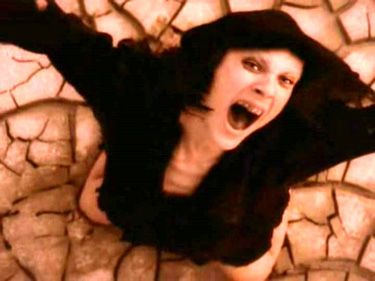Holy Saturday

Nyssa, Tolkien, and Gibson
By killing Jesus, Satan had swallowed God's bait. He didn't know he had swallowed the Godhead, thereby inviting Full Being into his fortress of nothingness and bringing about the ontological fall of his nothingness. In the words of St. Gregory of Nyssa: “The Godhead hid under the covering of our human nature so as to offer an easy bait to him who sought to exchange us for a more precious prize. And the aim was that just like a greedy fish he would swallow the hook of divinity together with the bait of the flesh. Thus life would come to dwell in death, light would appear in darkness, and thus light and life would achieve the destruction of all that stood against them.”
You can imagine Satan's smile as Jesus was sucked into the abyss. After watching Jesus enter hell, Satan was probably about to turn his attention back toward earth. But according to an ancient homily from Holy Saturday, Jesus, upon entering hell, met Adam, took his hand and raised him up, saying: “Awake, O sleeper and rise from the dead, and Jesus will give you light. . . I order you, O sleeper, to awake. I did not create you to be held a prisoner in hell. Rise from the dead, for I am the life of the dead. Rise up, work of my hands, you who were created in my image.”
Thus the terror was reversed: The tormentor, Satan, became the tormented; the tormented, Jesus, became the tormentor; hate, the weapon of the first tormentor, was replaced with love, the weapon of the second tormentor.
It's difficult to imagine the full terror that raced through Satan as he realized what was happening, but there's an excellent literary analogy toward the end of J.R.R. Tolkien's The Lord of the Rings and the torment that befell Sauron, Tolkien's literary parallel to Satan. The hobbit, Frodo, bearer of the Ring that was the source of Sauron's power, had sneaked into the middle of Sauron's kingdom, Mount Doom, and stood at the abyss of the Crack of Doom, home of the only fires fierce enough to destroy the Ring: “The Dark Lord was suddenly aware of him . . . and the magnitude of his own folly was revealed to him in a blinding flash . . . Then his wrath blazed in consuming flame, but his fear rose like a vast black smoke to choke him. For he knew his deadly peril and the thread upon which his doom now hung. From all his policies and webs of fear and treachery, from all his strategems and wars his mind shook free; and throughout his realm a tremor ran, his slaves quailed, and his armies halted, [Sauron's] whole mind and purpose . . . was now bent with overwhelming force upon the Mountain. At his summons, wheeling with a rending cry, [Sauron's highest servants, the Ringwraiths] hurtled southwards to Mount Doom.”
But they got there too late. The Ring had been destroyed, and with it Sauron's power.
Like his literary personification Sauron, Satan must have streaked southwards–downwards–to hell, only to watch helplessly as his evil work was undone. Ontologically speaking, man's path to being had been restored and the path to nothingness, though still open to those who choose it, had been redirected to the path of Heaven. The path to full existence was opened to any person willing to accept the redemption–the restoration of man's being–effected by Jesus' death and resurrection.
